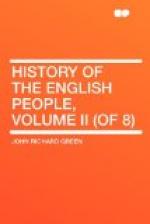this bondage however Scotland was freed by the prodigality
of Richard who allowed her to buy back the freedom
she had forfeited. Both sides fell into their
old position, but both were ceasing gradually to remember
the distinctions between the various relations in
which the Scot king stood for his different provinces
to the English Crown. Scotland had come to be
thought of as a single country; and the court of London
transferred to the whole of it those claims of direct
feudal suzerainty which at most applied only to Strathclyde,
while the court of Edinburgh looked on the English
Lowlands as holding no closer relation to England
than the Pictish lands beyond the Forth. Any
difficulties which arose were evaded by a legal compromise.
The Scot kings repeatedly did homage to the English
sovereign but with a reservation of rights which were
prudently left unspecified. The English king
accepted the homage on the assumption that it was rendered
to him as overlord of the Scottish realm, and this
assumption was neither granted nor denied. For
nearly a hundred years the relations of the two countries
were thus kept peaceful and friendly, and the death
of Alexander the Third seemed destined to remove even
the necessity of protests by a closer union of the
two kingdoms. Alexander had wedded his only daughter
to the King of Norway, and after long negotiation
the Scotch Parliament proposed the marriage of Margaret,
“The Maid of Norway,” the girl who was
the only issue of this marriage and so heiress of
the kingdom, with the son of Edward the First.
It was however carefully provided in the marriage treaty
which was concluded at Brigham in 1290 that Scotland
should remain a separate and free kingdom, and that
its laws and customs should be preserved inviolate.
No military aid was to be claimed by the English king,
no Scotch appeal to be carried to an English court.
But this project was abruptly frustrated by the child’s
death during her voyage to Scotland in the following
October, and with the rise of claimant after claimant
of the vacant throne Edward was drawn into far other
relations to the Scottish realm.
[Sidenote: The Scotch Succession]
Of the thirteen pretenders to the throne of Scotland
only three could be regarded as serious claimants.
By the extinction of the line of William the Lion
the right of succession passed to the daughters of
his brother David. The claim of John Balliol,
Lord of Galloway, rested on his descent from the elder
of these; that of Robert Bruce, Lord of Annandale,
on his descent from the second; that of John Hastings,
Lord of Abergavenny, on his descent from the third.
It is clear that at this crisis every one in Scotland
or out of it recognized some sort of overlordship
in Edward, for the Norwegian king, the Primate of
St. Andrews, and seven of the Scotch Earls had already
appealed to him before Margaret’s death; and
her death was followed by the consent both of the
claimants and the Council of Regency to refer the




